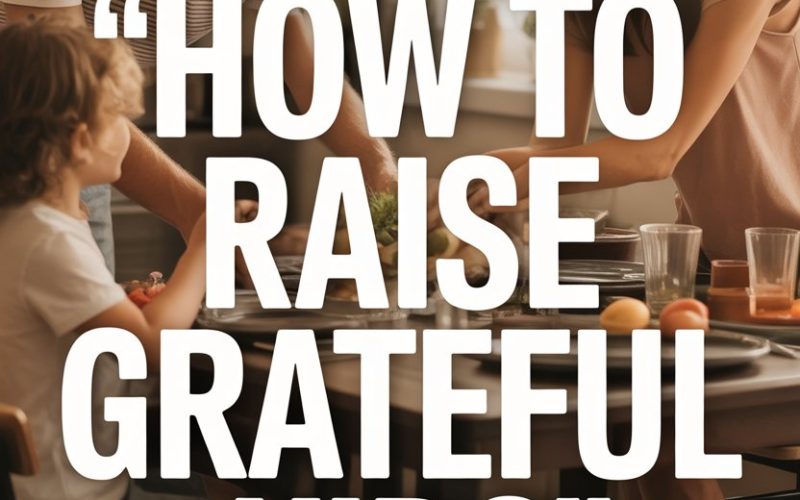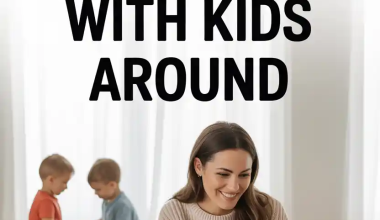If you’ve ever handed your child a lovingly-prepared sandwich—complete with the preferred brand of peanut butter and a note scrawled on a napkin—only to be met with a sigh and “But I wanted triangles, not rectangles,” you’ve probably wondered if gratitude is extinct.
Good news: it isn’t. It’s just really good at hide-and-seek.
Now for the fun part: raising grateful kids, even when you’re running on caffeine and a prayer. With a little intention, you can help your child go from “Is this all?” to “Wow, thanks!”.
Here’s how.
Keep Gratitude Simple and Everyday
Gratitude doesn’t need to be wrapped up with sparkly paper and handed out at holidays.
The magic happens in the little moments: a thank-you for picking up socks, an appreciative smile when you hand over snack number four of the afternoon.
Model everyday gratitude using real words, not just a half-hearted “cheers”. If you’re thankful your partner unloaded the dishwasher, say so. Kids are like parrots (adorable, messy parrots); they mimic what they see.
Show them that gratitude isn’t just for big moments but for the ordinary, slightly soggy Tuesday afternoons too.
It’s tempting to save “thank you” for grand events, but research from Harvard Health shows that making gratitude a casual, daily habit is what wires it into our brain.
The more frequently kids see and hear authentic appreciation, the more likely they are to soak it up.
Teach Them the Magic Word and Why It Matters
Every frazzled parent has been there: staring down a child who’s clinging to a new toy and refusing to mutter those two syllables—thank you. Turns out, just saying the words isn’t the same as actually feeling grateful.
Instead of drilling them like a Victorian headmistress, give them the why behind the words.
“We say thank you because someone took time to help us, and that’s worth noticing.” When kids understand the reason, the words turn from duty to delight. Or at least, less of a chore.
If you need backup, science is on your side. Psychologists like Dr. Robert Emmons have found that children who understand the meaning behind gratitude are more likely to feel it—and express it—genuinely.
Make Giving and Receiving a Two-Way Street
If your house is anything like mine, gifts flow in around birthdays and holidays like a tidal wave. But gratitude can get lost in the wrapping paper.
Flip the script. Invite your kids to help pick out or make gifts for others—even if that means an epic glitter cleanup.
When children experience the joy of giving, they’re more likely to recognise the effort behind receiving.
Take it a step further by including them in thank-you note rituals. Not in the mood to buy stationary? A video message or a creative drawing does the trick.
What matters is pausing to acknowledge: “Hey, someone thought of me.”
Share Stories That Illustrate Appreciation
Curling up with a good story is a classic parenting trick—great for bedtime, rainy days, or when you just want everyone to sit still for five minutes. Sneak in books that centre on gratitude, generosity, or kindness.
Think “Last Stop on Market Street” by Matt de la Peña, or “Those Shoes” by Maribeth Boelts. Stories paint gratitude in living colour, sparking empathy and discussion without a single lecture.
Over time, kids start to spot these moments in real life.
If you’re feeling especially clever, share your own stories from childhood. Tales of boring gifts you came to treasure, or the time you found a tenner in your coat and remembered your mum’s kindness.
Kids love glimpses into your “olden days” and learn a thing or two along the way.
Encourage Thankfulness When It’s Tough
Here’s where things get tricky: encouraging gratitude during moments of disappointment.
No one expects your child to do a full Beyoncé thank-you speech after receiving socks from Auntie Sue. But they can practice finding a silver lining.
Try this: when plans change or things don’t go their way, acknowledge their feelings first (because no, gratitude doesn’t mean ignoring frustration). Then, gently prompt, “Is there anything good about this, even just a tiny thing?”
Over time, this habit helps kids see gratitude not as forced cheerfulness, but as a tool for resilience.
Studies from the University of California, Davis suggest that grateful people cope better with stress—not because life is perfect, but because they notice what’s working, even when plenty isn’t.
Get Kids Involved in Acts of Kindness
On the surface, gratitude is about receiving. Underneath, it’s as much about giving. Involving kids in small acts of kindness gets them out of their own heads and tunes them in to others.
This doesn’t mean volunteering every weekend (unless you enjoy wrangling toddlers at the community garden). Start small: baking biscuits for a neighbour, running an errand for a relative, leaving a chalk message on the pavement.
The key is helping kids experience the simple joy of brightening someone’s day.
Experts at the Greater Good Science Center emphasise that generosity nurtures gratitude. When children see the ripple effect of their kindness, they begin to appreciate the many ways others add to their own lives.
Create Simple Gratitude Rituals
You don’t need to become a gratitude guru or start chanting before breakfast. Rituals can be as easy as sharing one thing you’re grateful for at the dinner table, or during the mad dash to school.
No shame if your child’s answer is “my tablet” or “pizza night”—the goal is consistency, not poetic depth. Over time, you’ll notice answers get more thoughtful.
And yes, parents should join in too. This shared reflection is a subtle reminder that everyone, even grown-ups, has something to feel thankful for.
For the tech-minded, apps like Happyfeed make family gratitude sharing quick and fun. Snap a photo, jot a sentence, and watch your family’s “grateful moments” pile up.
Let Kids Experience Disappointment
Here comes the parenting truth bomb: if kids get everything they want, gratitude doesn’t stand a chance. Disappointment is an underrated teacher.
When children face a “no” every now and then, they learn to value the “yes”.
Resist the urge to swoop in and fix every tiny letdown. By allowing space for disappointment (without rubbing it in), you help your child develop perspective.
Sometimes, the greatest gift you can give your child is a chance to miss out—and then realise, days or weeks later, how much they appreciate what they do have.
Don’t Sweat the Eye Rolls
If you’re waiting for your child to thank you with the enthusiasm of an Oscar winner, you might be waiting a while. Gratitude, like a good sourdough starter, takes time to develop. You’ll get grunts, mumbles, and maybe even the odd sarcastic “thanks a lot” along the way.
Stay patient. Keep modelling, keep prompting, keep sharing your own moments of appreciation. Progress doesn’t always look like you expect.
One day, when you least expect it, your child will surprise you with a heartfelt thank-you—and you’ll know your efforts are taking root.
Finding Gratitude in the Chaos
No one ever said raising grateful kids was a walk in the park—especially when the park is full of mud puddles and someone left their wellies at home. But small, daily acts add up, even on the messiest days.
Whether it’s a quick thank-you in the car, a shared giggle about a silly story, or a pause to appreciate the way the dog always knows when you need a cuddle, gratitude sneaks in. Little by little, it grows.
And who knows? One day, you might just hear, “Thanks, Mum. This is perfect—even in rectangles.”





